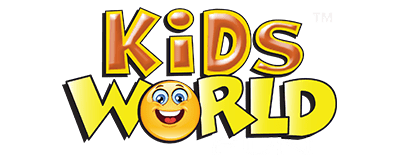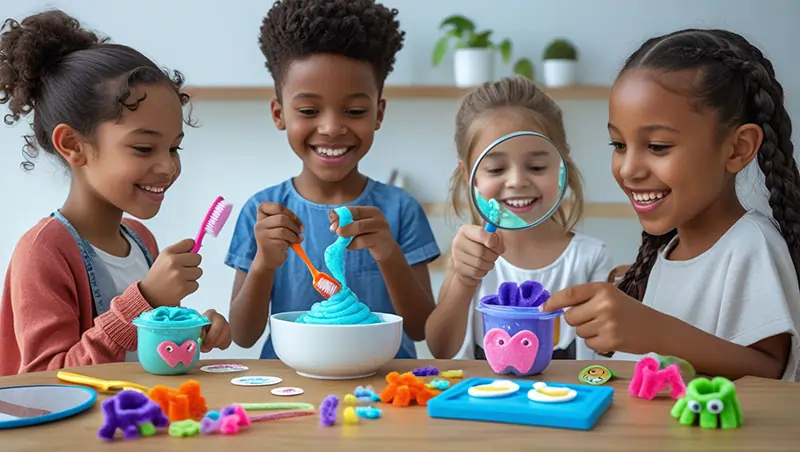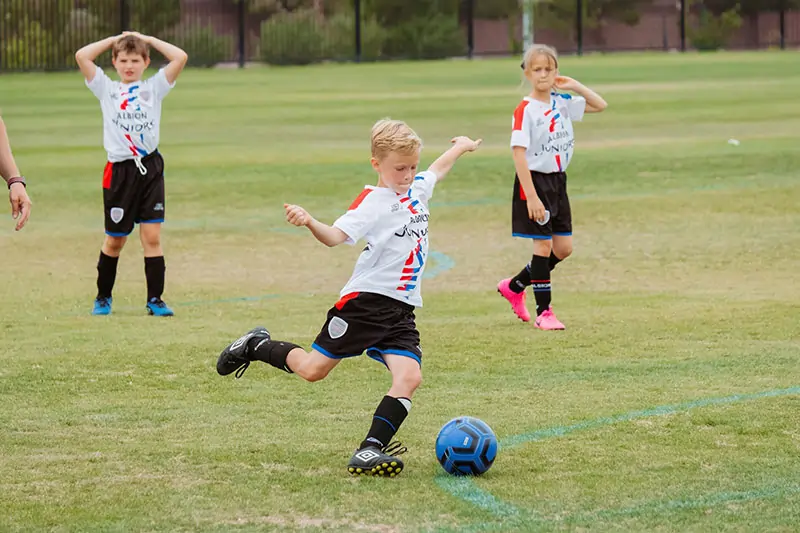DIY Dental Health Projects for Kids
Why Hands-On Dental Health Activities Matter
Educating children about oral health with hands-on exercises is a great method to teach the subject in a fun and interactive manner. Kids are best taught when they can see, feel, and do something, which reminds them of the proper dental care habits in a meaningful way.
A. Educates Children About the Significance of Oral Hygiene in a Fun Way
When kids participate actively in dental health activities, they learn more about why brushing, flossing, and healthy eating are essential. Instead of being told to brush, they see for themselves how sugar harms their teeth (e.g., with the Eggshell Cavity Experiment) or how flossing removes hidden debris (e.g., with Playdough and LEGO).
?Lesson Learned: Hands-on activities allow children to better understand the process of plaque formation and tooth decay, and they will be more inclined to look after their teeth.
B. Promotes Good Habits Such as Brushing and Flossing
Developing entertaining and engaging activities around oral care promotes healthy habits in the long run. Incorporating games, do-it-yourself activities, and reward schemes makes brushing and flossing a fun part of the daily routine rather than a chore.
C. Makes Dental Care Less Intimidating by Linking It to Fun
Many children feel anxious about visiting the kids dentist. But if children are taught dental health in a fun way at home, they develop good oral care associations.
- Pretend play with a stuffed animal dentist game can make real dental visits feel less scary.
- Seeing dentist-themed cartoons or reading books tends to normalize dentist visits.
- Using timers and brushing challenges turns brushing into a fun activity rather than a task to be rushed through.
DIY Dental Health Projects for Kids
Eggshell Cavity Experiment (Understanding Tooth Decay)
Purpose: This experiment helps children visualize how acidic and sugary drinks can damage their teeth over time.
Materials Needed:
✔ Hard-boiled eggs (representing teeth)
✔ Soda (cola, juice, or sports drinks)
✔ Vinegar
✔ Water (as a control)
✔ Clear cups
Activity Steps:
- Fill three clear cups—one with soda, one with vinegar, and one with water.
- Place a hard-boiled egg in each cup and leave them for 24 hours.
- Remove the eggs and observe the differences in the shells.
- The egg in vinegar will have a softened or eroded shell due to its acidity.
- The egg in soda will likely be stained and weakened from the sugar and acid.
- The egg in water will remain unchanged, showing it is the safest option for teeth.
? Lesson Learned: Sugary and acidic drinks weaken and stain teeth, just like they damage the eggshells. Drinking water is the best way to protect teeth from decay and discoloration.
Flossing Fun with Playdough and Legos
Purpose: This hands-on activity teaches children why flossing is necessary to remove food particles stuck between teeth.
Materials Needed:
✔ Playdough (represents food particles)
✔ Large LEGO block or ice cube tray (represents teeth)
✔ Floss
Activity Steps:
- Pack playdough into the small spaces between the LEGO bumps or ice cube compartments to mimic food getting stuck between teeth.
- Hand your child a piece of floss and encourage them to remove the playdough by flossing between the gaps.
- Observe how brushing alone (rubbing the top of the LEGO with a toothbrush) doesn’t fully remove the playdough, reinforcing the importance of flossing.
Sugar Detective Game
Purpose: This activity helps kids recognize the hidden sugars in everyday foods and encourages them to make healthier choices for their teeth.
Materials Needed:
✔ Food labels from common snacks (juice, yogurt, granola bars, cereal, etc.)
✔ A chart or worksheet
✔ Markers or stickers
Activity Steps:
- Gather different packaged foods and drinks with nutrition labels.
- Show kids how to find “Total Sugars” in grams on each label.
- Convert grams into teaspoons (1 teaspoon = 4 grams of sugar) and record the amounts on a chart.
- Discuss which foods are high in sugar and which are better for dental health.
- Create a “Tooth-Friendly” and “Caution” section on the chart and place each food accordingly.
? Lesson Learned: Many everyday foods contain hidden sugars that can contribute to cavities. This activity helps children develop the habit of checking nutrition labels and choosing low-sugar options to protect their teeth.
DIY Toothbrush Timer (Encouraging Proper Brushing Time)
Purpose: Kids often rush through brushing. This project makes it fun and encourages them to brush for the full two minutes recommended by dentists.
Materials Needed:
✔ A small hourglass timer (2-minute sand timer) or a homemade countdown timer
✔ Stickers, markers, or craft supplies for decoration
✔ A stopwatch or phone timer (optional)
Activity Steps:
- Give kids a 2-minute sand timer or help them create a simple DIY timer (such as a decorated paper plate with a rotating arrow).
- Let them make it their own with stickers, drawings, or their favorite color.
- Set the timer in the bathroom next to their toothbrush.
- Make them begin the timer each time they brush, so they brush the full two minutes.
Healthy Teeth vs. Cavity Teeth Collage
Purpose: This activity assists children in seeing the difference between good and bad oral habits, emphasizing healthy choices for healthy teeth.
Materials Needed:
✔ Old magazines or printed images of food and teeth
✔ Glue
✔ Construction paper or poster board
✔ Markers or crayons
✔ Scissors
Activity Steps:
- Divide a large piece of paper into two sections:
- Label one side “Healthy Teeth” and the other “Cavity Teeth.”
- Ask children to draw or cut out various foods, beverages, and oral hygiene practices.
- On the “Healthy Teeth” side, glue photos of things such as apples, cheese, water, toothbrushes, and floss.
- On the “Cavity Teeth” panel, attach photos of junk foods, colas, candies, and missing teeth.
- Ask the children to cover the collage with drawings of happy and sad teeth to highlight the contrast.
Encouraging Kids to Maintain Good Oral Hygiene
Here are some engaging strategies to keep children motivated:
Reward Systems (Sticker Charts for Consistent Brushing)
Purpose: Encourages children to brush and floss daily by using positive reinforcement.
How It Works:
✔ Create a brushing and flossing chart with spaces for morning and night.
✔ Have children place a sticker or checkmark each time they finish their routine.
✔ Establish a goal (e.g., 10 days of good brushing) and provide a reward such as a special trip, a new toothbrush with a favorite character, or a family fun activity.
? Lesson Learned: Lesson Learned: Establishing consistent habits by means of a reward system makes oral care more of an accomplishment than a task.
Brushing & Flossing Challenges with Family Involvement
Purpose: Makes brushing oral hygiene something fun to do instead of something boring to get done.
How It Works:
✔ Family Brushing Time: Get parents and siblings to brush at the same time to share in the experience.
✔ Brushing Race: Timer race–who can brush for the complete two minutes with the most gusto.
✔ Flossing Challenge: Find out who can floss out all the “plaque” (playdough from the LEGO flossing activity) the quickest.
? Lesson Learned: Lesson Learned: Kids are more likely to develop a habit that parents and siblings practice regularly.
Reading Books or Watching Cartoons About Dental Health
Purpose: Makes learning about oral care fun and relatable by using stories and engaging characters.
How It Works:
✔ Read books like The Tooth Book by Dr. Seuss or Brush, Brush, Brush! by Alicia Padron to make dental care entertaining.
✔ Watch cartoons with positive oral health messages, such as Peppa Pig’s Dentist Trip or Dora the Explorer’s Tooth Adventure.
✔ Role-play as a dentist using stuffed animals or dolls to reinforce brushing techniques.
? Lesson Learned: Children learn best through stories and pictures, so books and cartoons are an excellent means of reminding them of the significance of oral health.
By integrating these interactive and fun approaches, kids will be more enthusiastic to continue their daily brushing and flossing practice, resulting in a lifetime of healthy, robust teeth!



